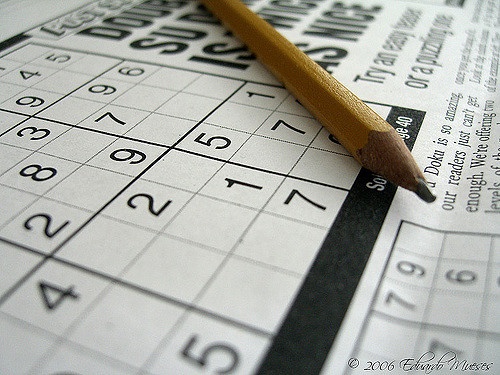
First let’s get started with some terminology so you’ll know what the heck we’re talking about when we dig into some strategies.
Backdoor
A backdoor more or less refers to a scenario in which the puzzle can be solved through the use of a single candidate, and all puzzles have a few of these backdoors. Using a backdoor is considered a trial and error solving technique.
Big Number
A big number is a number that is the solved value for a cell. Cells without a big number have candidates, or small numbers.
Bilocation (unit)
A unit (two cells) with the same two candidates remaining. These units allow for the implementation of various solving techniques.
Bivalue (cell)
A single cell with two possible candidates remaining. Like the above units, this cell becomes useful for trying out different solving techniques.
Box
A standard Sudoku board is comprised of 9 boxes, each with 9 cells arranged in a 3×3 formation. Each box must contain one of each of the digits from 1-9.
Candidate
A candidate is any number that could still be a possible solution for a cell. Eliminating candidates is one of the prime objectives of many Sudoku solving techniques and strategies.
Cell
A single square on the Sudoku board. A standard board is comprised of 81 of these cells. Each cell is part of one row, one column, and one box.
Column
There are 9 vertical columns on each Sudoku board, with 9 cells in each. Along with rows, these columns are often referred to as lines. Each column must contain one of each of the digits from 1-9.
Coordinates
The standard way to refer to a specific cell is to use coordinates in the format R#C#, which means the row number followed by the column number. So if I was referring to the cell in the fifth row from the top, and the 4th column from the left, it would be cell R5C4. This guide will use similar terminology when explaining strategies, and Sudoku software programs also use this numbering system.
Given
The cells which have values placed them to get the player started are called givens. These values cannot be altered, and set up the difficult of the entire puzzle. Most Sudoku puzzles have a minimum of 17 givens, as this is the minimum amount necessary to provide the puzzle with a unique solution.
Guess
Unlike trial and error, guessing is not considered logical in any way, and is frowned upon by most Sudoku players. A guess is often used by players when they’ve run out of solving techniques to utilise, including trial and error. The player would then fill in one or more boxes with guesses and continue to solve the puzzle based on those guesses, in an attempt to see if a solution can be reached. As Sudoku is considered a game of logic, and each board can be solved through logic alone, guessing is often seen as cheating and/or giving up and admitting defeat at the hands of the board.
House
Each group of 9 cells is considered a house, whether it be a row, column, or box. The standard Sudoku board contains 27 houses, and each must contain one of the numbers from 1-9.
Improper Sudoku
A Sudoku board which has multiple possible solutions.
Line
Rows and columns are often called lines. There are 18 of these lines, 9 rows and 9 columns, on a standard Sudoku board.
Peer
A peer is any cell located within the same house as the cell in question. Each cell has 20 different peers, 8 within the box, and 6 along that cell’s row and column, outside the box. None of a cell’s peers may contain the same number as it.
Proper Sudoku
This is a board which only has one possible correct solution.
Row
There are 9 horizontal rows on each Sudoku board, with 9 cells in each. Along with columns, these rows are often referred to as lines. Each row must contain one of each of the digits from 1-9.
Small Number
Small numbers are also known as candidates or pencil marks. They are numbers which are possible big numbers for that cell, though it isn’t certain which of the small numbers is the actual big number yet.
Strong Inference
A strong inference is a deduction that can be drawn from two candidates which are linked. For example, both candidates in such a scenario could not both be false without causing a conflict, allowing the player to surmise that one is true and the other false. Weak inference can be used in a similar way, though in its case, it implies that both scenarios cannot be true, so if one is true, the other is automatically false.
Strong Link
Link between 2 different candidates in a cell or unit with only 2 remaining candidates. These are great for solving techniques, as they assure that one of them must be true, and the other false. Weak links on the other hand, in which more than 2 candidates remain, are still useful for techniques, but take more work to uncover.
Trial & Error
A viable solving method, though more serious players may not use it, and consider just a step above guessing. Still, trial and error is a logical method to reach conclusions about candidates or values, so should not be discarded. Many other solving techniques use some form of trial and error in their own methodology.

Be the first to comment